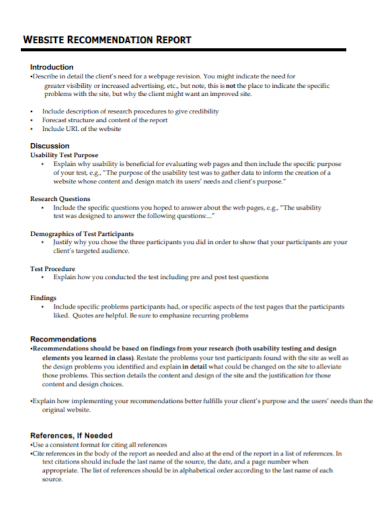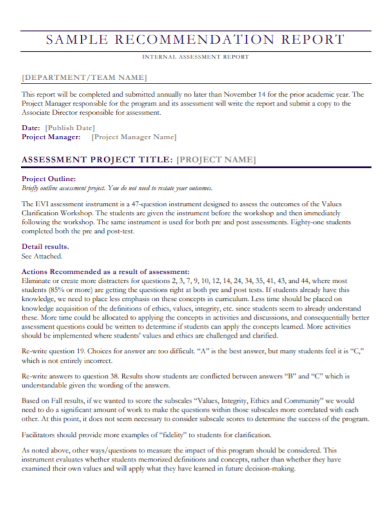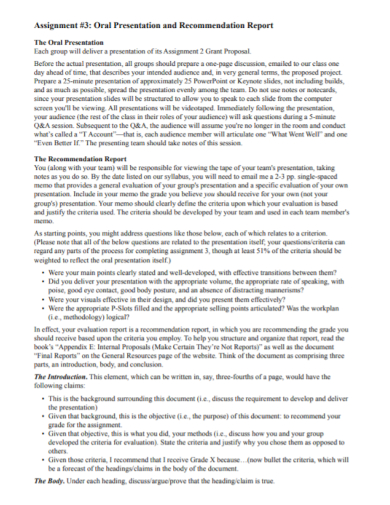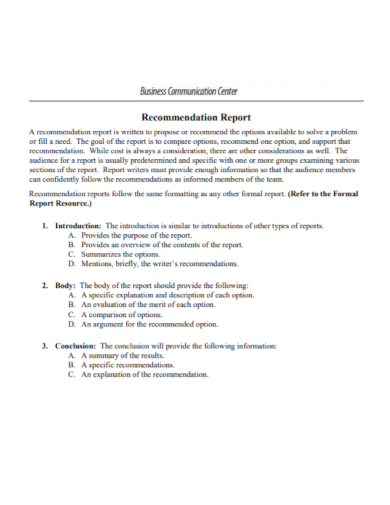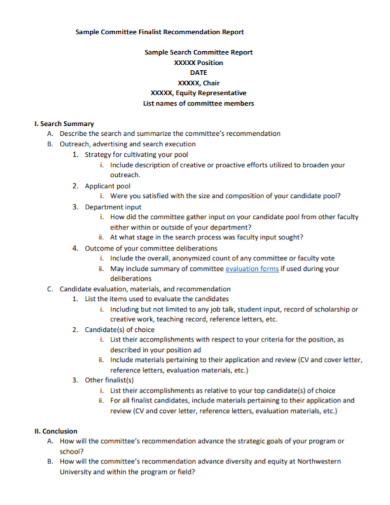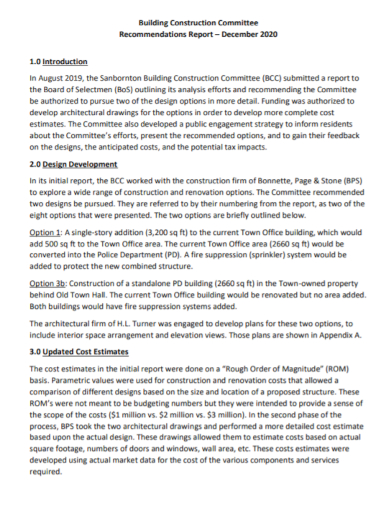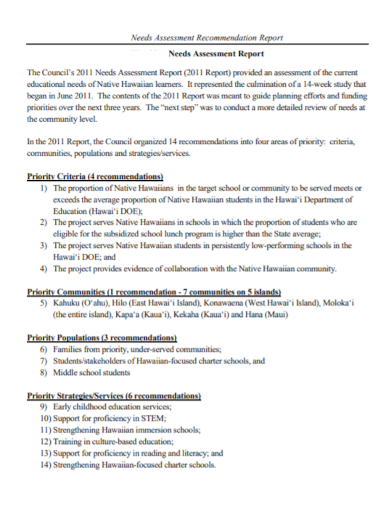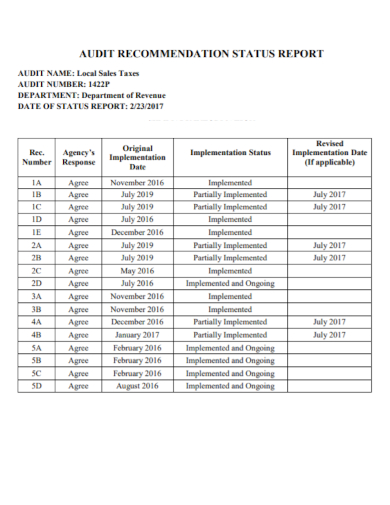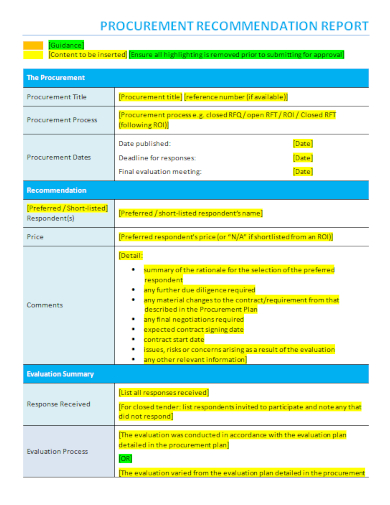A recommendation report is a vital role in the future of an organization in that it is a carefully drafted written report in which the productivity and even longevity of the organization can be predicted based on the suggested course of actions. Since it is one of the determining factors to make or break the foundation of an institution, creating a recommendation report is as important as the business’ policies on which it is anchored on. Let’s take a look at the salient features of a recommendation report that one should take into consideration. To get started, check and download our free sample recommendation report templates that will greatly help you.
10+ Recommendation Report Samples
1. Consulting Recommendations Report Template
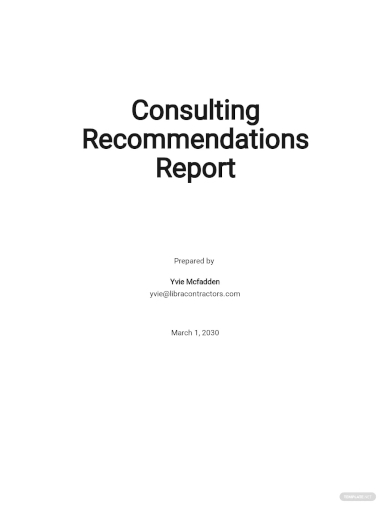
2. Recommendation Report Template
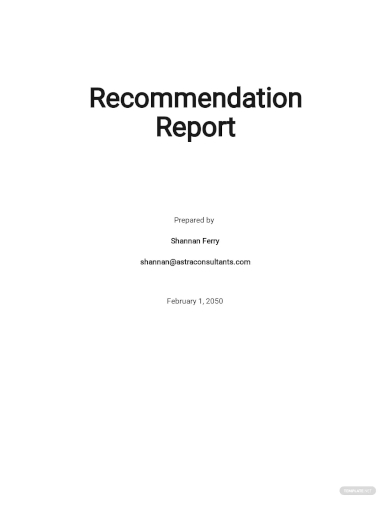
3. Website Recommendation Report
4. Project Recommendation Report
5. Oral Presentation Recommendation Report
6. Business Recommendation Report
7. Committee Finalist Recommendation Report
8. Building Construction Recommendation Report
9. Needs Assessment Recommendation Report
10. Audit Recommendation Status Report
11. Procurement Recommendation Report
Contents of a Recommendation Report
1. Summary
Just like any other report, don’t forget to include the summary of your recommendation report to steer the readers to the parts of the paper that they will be reading. This part also establishes the hype to keep the attention of the reader.
2. Statement of the Problem
This is the main part of a strong recommendation report from which all other parts stemmed from. The problem statement is the concern, issue, or shortcoming of a certain project or an organizational strategy that a group of people focus their attention on so that it could be avoided in the future. The recommenders also include here some related studies or identified situations in the organization that was given similar recommendations but failed to thrive in following the recommendations for some reasons.
This is also where the overview of the corporate resolution is written and should be based entirely on the problem at hand, the structure of the organization given its circumstances, and the challenges it is facing.
3. Describing the Options
This part of the recommendation reveals at least 3 options to resolving the problem stated that needs to be addressed. The options can be presented with overlapping ideas or can also be completely different from each other. Either way, each option should be written in a way that they are cohesive and comprehensive, answer what needs are mentioned in the statement of the problem, narrate the steps of their implementation towards resolving the problem, and convincing in justifying the effectiveness of the option.
4. Evaluation of Options
After presenting the options to resolve the problem, evaluating them comes next and should be cross-examined to find possible loopholes to their effectiveness. To do this, criteria for evaluation must be created as a guide to answer the questions of practicality and the chances of success of each option.
5. Final Recommendation
After going through the grueling process of scrutinizing each option, the recommenders will now decide which is the most promising and has the greatest chance of success based on the feasibility as well as its impracticality. This recommendation should be written in an argumentative way and possibly contain a number of sub-ideas that will serve as the reasons as to why it is the best option among others. This goes without saying that the recommendation is defended through solid facts and persuasive outcomes.
6. Conclusion
This concludes the whole paper which can also serve as a summary report of all the processes encountered to finally come up with a final recommendation. This is also where the writers leave the readers in awe or sustain their interests to continue on the actual implementation of the recommendations.
FAQs
What does data gathering mean?
It is the process of collecting data to support or explain a hypothesis or an idea over a set of boundary conditions.
What is a timeline?
Describes the work progress of a study or an activity at specific times. It also describes how much time to execute ideas or plans.
What is a feasibility study?
It is a system or a strategy to measure the viability of something to be a success or a failure.
Related Posts
FREE 7+ Sample Academic Recommendation Letters
FREE 17+ Financial Audit Report Samples
FREE 11+ Safety Audit Report Templates
FREE 11+ Sample Executive Reports
FREE 10+ Consultant Letter Samples
FREE 10+ Budget Report Samples
FREE 10+ Book Review Templates
FREE 8+ Sample Internship Recommendation Letter Templates
FREE 8+ Investigation Summary Report Samples
FREE 7+ Administrative Assistant Reference Letter Templates
FREE 15+ Business Activity Report Samples
FREE 10+ Consultant Report Samples
FREE 9+ Recruitment Report Samples
FREE 8+ Sample Report Outline
FREE 8+ Sample Physician Recommendation Letters

